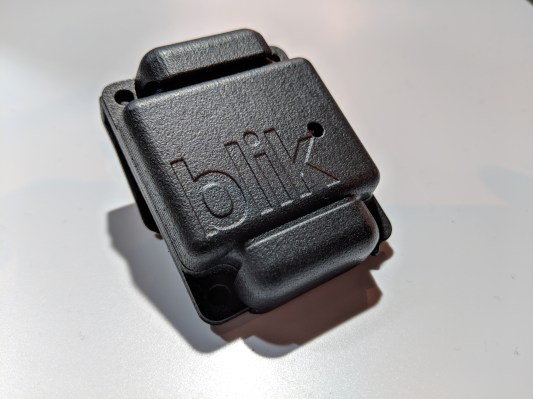Knowing what’s in your warehouse, where certain items are stored and where they are in the production process is highly valuable information for any manufacturer. But today, gathering this information is typically done with barcodes and scanners — and scanning these codes can take up a large part of a worker’s day.
Blik, which is presenting in the TechCrunch Disrupt Berlin Startup Battlefield today, aims to modernize this process and make it as hands-off as possible by using a combination of wireless sensors and indoor location tracking.
The founding team of Bastian Burger (CEO), Victoria Hauzeneder (CTO) and Phillip Eller (COO) launched the company about a year ago. At the time, they were studying at the Technische Universität München (TUM) and working closely with BMW through a combination of internships and various university programs. The team realized that BMW’s systems for warehouse logistics left a few things to be desired. The result was a first (and very hacky) version of Blik that mostly relied on Raspberry Pis and other (largely ZigBee-based) hardware that was mostly meant for home automation.
“We started talking to BMW — but it wasn’t just BMW that needed this solution,” Eller told me. “We realized that there was a big need for this track and trace technology.”
[gallery ids="1574555,1574558,1574559,1574554"]
To expand beyond these first prototypes, the Blik team now builds its own hardware, after having already built its own software stack. The hardware, which the company plans to offer as part of a software-as-a-service subscription, combines the sensors that sit on the load carriers inside the warehouse and a receiver system to receive the pulses that these sensors emit at regular intervals.
To determine the position of a sensor inside the warehouse (where GPS doesn’t work and where Bluetooth isn’t practical), the team first needs to scan the warehouse and gather enough data to allow for triangulating the position of the sensors. The team tells me that it can then determine the position with about a 5-meter accuracy. Because the system also tracks the equipment’s steps through the manufacturing process, that’s more than enough accuracy for most users. Because most of Blik’s potential users currently use SAP, the team also worked closely with SAP to integrate their systems, but it also offers a standard Rest API for those who want to build their own integrations.
In addition to working inside of warehouses, Blik’s users could also install receivers on their trucks to keep track of their products while they are on the road.
Right now, Blik is mostly working with car manufacturers like BMW and Volkswagen’s MAN group. In total, the company has signed six deals so far, which typically start with a two- to six-month pilot phase.
The team, which dropped out of college to start this company, has received about $170,000 in government grants and another $240,000 in revenue from its pilot projects with its first users. The founders, who recently hired their first employee, are now looking to raise additional money to expand and bring on new users.
